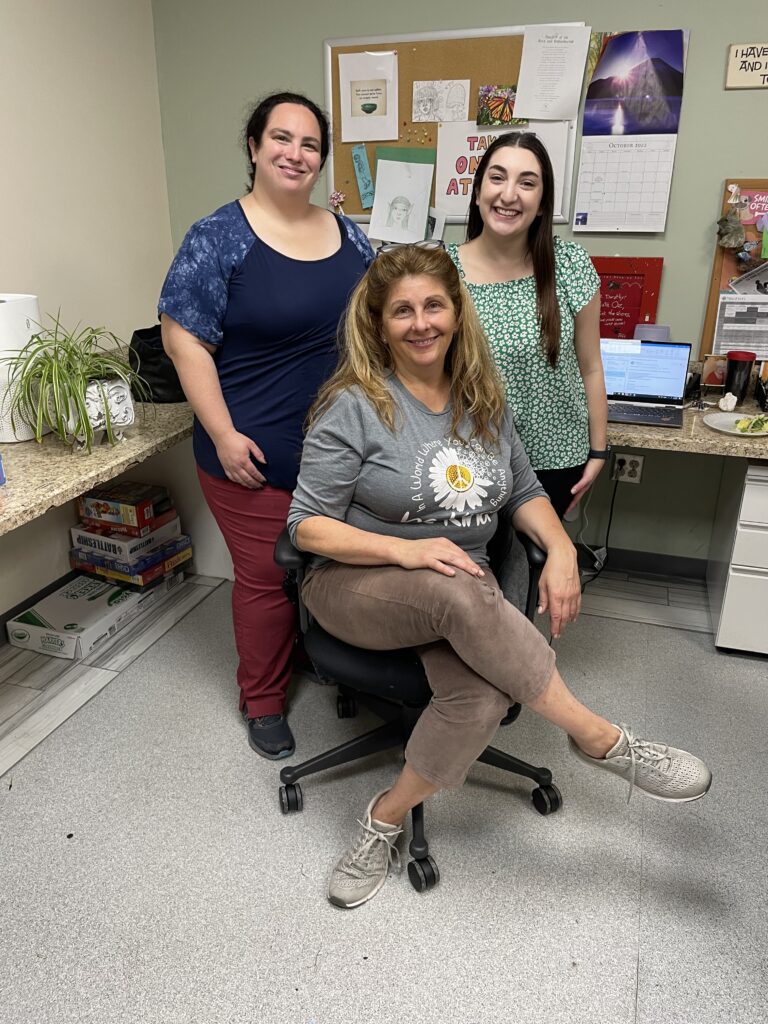Supporting young people in addressing mental and behavioral health challenges is hard work both for patient and staff on MiraVista’s adolescent inpatient unit.
It is also life-changing.
Programming is designed for patients to leave with better coping skills, often reinforced by new-found confidence in themselves, and fostered by therapists like Melody Joy, Caitlin Anable and Hannah Silverman who were asked to share what they do during MiraVista’s observances of Mental Illness Awareness Week.
Caitlin and Hannah are group therapists on the adult inpatient psychiatric units, but help Melody, the primary group therapist on the adolescent unit, cover that unit when needed.
The three work together, supporting each other and the teens in their care, ages 13 to 18, in navigating the day that can be chaotic, unpredictable and rewarding, too.
Symptoms of mental illness and rates of suicidal thoughts have dramatically increased nationwide in recent years among adolescents, but addressing their mental and behavioral conditions can help prevent such conditions from becoming chronic or more severe.
“I get regular compliments from adolescents with whom I work,” Caitlin said. “They tell me that they arrived in such a rut but that my positive energy is something they feel and draw from when I am on the unit and that has helped them realize there is hope.”
The therapists try innovative ways of engagement in using Dialectical Behavioral Therapy (DBT), a type of talk therapy based on cognitive behavioral therapy, to teach the adolescents how feelings and emotions can impact actions.
“We try to take the worksheets out of it,” Melody said. “We try to implement fun ways instead, like giving them wrapped candy or a bottle of bubbles, when we are figuring out issues like impulse control.”
She added that other approaches include giving the teens clay and “asking them to mold something that makes them happy and that they can use, if they want, as a coping skill.”
“Some of the kids will create their dog or a flower,” Melody said. “They learn whatever figure they make can have a therapeutic value. Through doing the work of DBT in this way, they learn boundaries and such skills they may have never been taught like how to express themselves in a manner that is not aggressive.”
Caitlin said what the therapists do in terms of programming “doesn’t stop at DBT.”
“We do a mixture of everything,” Caitlin said. “It’s DBT. Its professional experiences. It’s instilling that resiliency factor into patients who have gone through multiple DBT programs. We look at how we can keep the same concept but instill it within their brains to be able to apply the material.”
Melody said the therapists’ efforts are directed at helping their adolescent patients realize that “they are capable and can handle more than they think they can.”
“We let them know that being in here doesn’t make them weak,” Melody said. “The hard work for them, if they say they have anxiety or depression, for example, is owning the diagnosis but not becoming that label. We teach them that they are so much more than the illness.”
Caitlin said that if a patient “ever says they had a failure by coming into the hospital,” she rephrases it to say “it is not a failure but that they need a little extra support and there is nothing wrong with asking for help.”
“One of the great aspects with working with this age group is that they are still young and sometimes just the fact we showed them kindness in their darkest time will stay with them even if they have relapses,” Caitlin said.
Hannah added that “when you develop a really good therapeutic relationship with a patient, too, a lot of trust comes in and they are going to want to talk with you.”
“Adolescents are really good about talking to us because they know we are here for them,” Hannah said. “Some of our 1-on-1 sessions can be anywhere from 10 minutes to an hour and this can change how many people we can see in a day but we fit in as many as we can.”
Being available is key, Melody said, who on a recent day ran two group sessions for 11 patients each in addition to addressing the needs of individual patients.
“We are each other’s pillars and that enables us to be as successful as we are with our patients,” said Melody of the support the therapists give each other. “Our work is hard, but we are able to bounce things off each other.”
A former teacher who made mental health counseling her second career to better help the young people she viewed as “falling through the cracks,” Melody added that despite days “that can be exhausting,” she “would not want to be working anywhere but where I am.”
“Those aha moments, those moments when you know you have made a connection in helping a patient and they say, ‘I just need to talk with you, I need to sit with you,’ those are the rewards in doing this job and why I do it. Why we do it.” Melody said.

